“The Magic of the FA Cup” is a phrase you hear tossed around the world…
Getting to Know the Everton-Liverpool Merseyside Derby

Sometimes called the Friendly Derby, the Merseyside Derby between Liverpool and Everton is the longest-running top flight derby in English football, the two having played at least twice every season since 1962.
So let’s take a look at the history and some of the key games between these two great clubs and what is — despite a recent lack of competitiveness — one of the top derbies in English football.
First, we’ll start with a very brief history of each club, adapted from our guidebook, The Groundhopper Guide to Soccer in England. You can pick up your very own signed copy here.
In case you didn’t know, Merseyside simply means “by the side of the River Mersey,” on which the city of Liverpool was founded.
Everton History
Everton have, by some distance, spent more seasons in the top flight of English football than any other club in the country. That would be 117 seasons since the Football League was created in 1888. They have only missed four seasons up top and none since 1954.
They started across Stanley Park at Anfield then moved across to Goodison Park in 1892 over a rent dispute. The split led to the formation of Liverpool FC back at Anfield. The two have been eyeing each other across that mile-wide expanse of grass ever since. Note that Everton are slated to move into a brand-new 52,000-seat venue for the 2024-25 season.
Everton won two league titles and an FA Cup before World War I, but they hit it big in 1925 when they signed a striker named Dixie Dean. He still holds the record for goals in a league season — sixty in 1927–28 — and when he left in 1937, he had scored an incredible 349 goals in 399 appearances. (His statue is outside the ground.) By World War II, Everton had won three more league titles and another FA Cup.
They had another good run in the 1960s — two more league wins and another FA Cup — and then took off again in the 1980s, winning the league in 1984–85 along with the UEFA Cup Winners’ Cup and adding another league win in 1986–87. In both cases they were denied European football the following season because of the ban on English clubs there — ironically in large part because of the behavior of Liverpool fans. In all the years since, they have won one FA Cup, lost two finals, and have some minor dalliances in Europe to show for another thirty-plus years in the top division.
Liverpool History
In all of England, only their great rivals Manchester United have more to brag about than the Reds. But if you are younger than forty, you don’t remember the last time Liverpool was winning everything. And you might not know that before that great run established their elite status, in 1961, they were in the Second Division.
A couple of years before that, they had hired a manager named Bill Shankly. He used the club’s boot room as a legendary planning room for him and his assistants, and from that room emerged a dynasty. From 1964 to 1990, Liverpool under Shankly — succeeded by his assistants Bob Paisley and Joe Fagan, and later by player Kenny Dalglish — won thirteen league titles, four European Cups (today’s Champions League), four FA Cups, four League Cups, two UEFA Cups, and the UEFA Super Cup. From 1972 to 1990 they finished first or second in the league all but one season, winning it eleven times.
Since those memorable years, they have won three FA and four League Cups, and they bagged another European title in 2005 after a memorable comeback from being down 3–0 at a final in Istanbul. In 2018 they made an unexpected run to yet another Champions League final, their ninth, which they lost to Real Madrid. The following year they finished second in the league by one point in an epic title race with Manchester City but won the Champions League, beating Tottenham in the final for their sixth European crown.
In 2019-20, they won the league “at a canter,” their first such title in 30 years, and last season they secured another top-four finish to qualify for the Champions League for the fifth straight season. In 2022, they went on to win both the FA Cup and the League Cup, followed by the Community Shield in 2023. But following the 2023 season, they finished 5th and failed to qualify for the Champions League for the first time since 2016.
Origins of the Merseyside Derby
As soon as Liverpool FC came into existence, there was an obvious rivalry with their cross-park neighbors. Some of the early spirit was fed by the clubs’ membership and directors being split in part along sectarian and political differences. This lasted until the 1950s, when Everton had several prominent Irish Catholic players; Liverpool didn’t sign a Catholic player until 1979.
Everton won most of the early matchups, and in fact they held an overall lead in the derby until the 1980s:
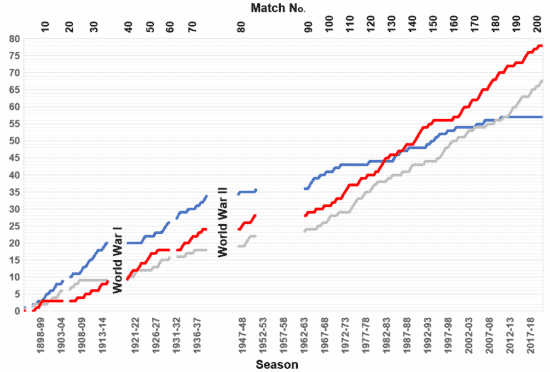
TurboGUY, CC BY-SA 4.0, via Wikimedia Commons
It came to be known as the Friendly Derby because, unlike other derbies, violence was quite rare between the two sets of supporters. As the sectarian differences between the clubs faded, a shared sense of being Liverpudlian above all else seems to have tempered things, and the citywide reaction to the tragedy of Hillsborough in 1989 further reminded everyone that football is only so important.
In 1954, Everton came up to the First Division, and Liverpool went down from it that same season. The two wouldn’t play again until the 1962-63 season, by which time they were each building a trophy-winning side.
Merseyside Derby in the 1960s
Everton won the league in 1963 and added the 1966 FA Cup. Liverpool won the league in 1964, the Cup in 1965, and the league again in 1966 — then beat their Merseyside rivals in the Charity Shield game to kick off the next season. Before that game, in August 1966 at Goodison Park, three players — two from Everton, one from Liverpool — paraded around the World Cup they had just helped England win the month before over Wembley.
While Liverpool won that one, 1-0, Everton would get some revenge by knocking the Reds out of the FA Cup at the Fifth Round that season.
So the 60s went, the two sides of Liverpool battling it out with a rising Manchester United for trophies. The decade culminated with another Everton league win in the 1969-70 season, followed by a memorable semifinal in the following year’s FA Cup, won by Liverpool 2-1 at Old Trafford in Manchester:
Shared Merseyside Glory in the 1980s
After their 1970 league triumph, Everton wouldn’t lift a trophy for 14 years. It was in the early 70s that Shankly famously quipped, “I always said we had the best two teams on Merseyside … Liverpool and Liverpool Reserves.”
The 80s were the glory days of the Merseyside Derby, with Liverpool winning everything in sight and Everton winning the league in 1985 and 1987 plus the FA Cup in 1984.
In between those triumphs, they finished second in a thrilling 1985-86 season in which they battled Liverpool all season for league and Cup glory.
The teams split the league matches that year, each winning away from home, and then a week after Liverpool beat the Blues to the title by two points, they met in the FA Cup Final at Wembley, where Liverpool took a 3-1 win to complete their double and cement their domination of English football that decade.
Note the opening goal by a certain current BBC “Match of the Day” host, as well as the composition of the crowd, famously more mixed in colors than other Cup finals.
Three years later, they were back at Wembley for another final, but this time in a very different setting. Recall that the Hillsborough tragedy, in which 96 Liverpool supporters died in a crush at Sheffield Wednesday’s home ground, was an FA Cup semifinal against Nottingham Forest. The Reds won when it was eventually played, then ran into who-else in the final.
This explains the even more mixed and festive mood, as well as the announcer’s opening line about togetherness.
The 1990s and 2000s: Fading Equality on Merseyside
After Liverpool won the league title in 1990 (their last before raising the trophy again in 2019-20), they would get just one more FA Cup that decade, as the glory days faded away. Everton got their last major trophy in the 1995 FA Cup Final, beating Manchester United.
As for the Merseyside Derby, Everton had the better of it in the 1990s, but since 2000 they have just five wins in 42 meetings, and only one win in the 24 meetings since October of 2010 (last season at Anfield, 2-0). The last time Everton topped the Reds in the table was 2005 — small consolation, perhaps, as Liverpool only went and won their fifth Champions League title that year.
A Brief Word for Tranmere Rovers, Also of Merseyside
There is actually another Football League club on Merseyside: Tranmere Rovers. They are across the Mersey in Birkenhead. So, technically, should either Liverpool or Everton run into Rovers, that would also count as a Merseyside Derby.
But since Tranmere are currently in League Two, it would appear that it will take an FA Cup Draw to create such a situation. That last happened in 2001, when amazingly, Tranmere — then in the second tier and with former Liverpool player John Aldridge as manager but former Everton player Paul Rideout in the squad — drew both! They beat Everton 3-0 at Goodison, then lost to Liverpool in the quarterfinals.
Let’s give Rovers some love here; this video adds a bit of history to the Everton tie and includes highlights with the Tranmere radio crew:
Liverpool do have a nice preseason tradition of playing a friendly with Tranmere at Prenton Park, above. You can get a sense of what it’s like seeing a game at Tranmere Rovers here.
Overall State of the Merseyside Derby
As of the start of the 2023-24 Premier League season, Everton and Liverpool have played an astonishing 293 times since 1894, with Liverpool winning 124 to Everton’s 83, with 86 draws.
The Mersyside Derby is still referred to on occasion as the Friendly Derby, particularly after incidents such as the two grounds being connected by interlocking red and blue scarves after Hillsborough, and the longstanding policy of not segregating fans in the stands — a real rarity in English soccer, much less in derbies.
On the field, however, despite a paucity of Everton wins and a bit of peace in the stands, the matchup leads the Premier League in red cards. And we can say from experience that nothing beats a derby celebration. We’ll close with a sample of what this game means to the blue side of Liverpool, with or without a recent record of success.
It’s the 2017-18 FA Cup Third Round, at Anfield. Since it’s a Cup tie, there are three times the normal number of Evertonians on hand, some 9,000 of them filling the Anfield Road End, opposite the Kop, where this play starts off.
This was filmed, by the way, from a hospitality package we sell at Anfield. Enjoy!



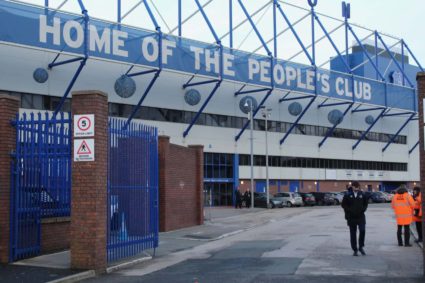
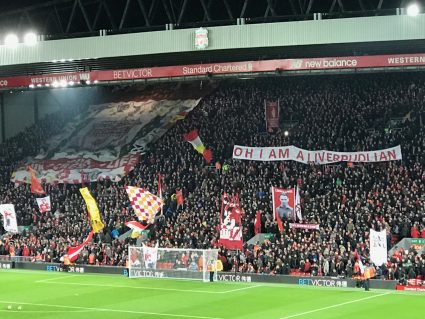
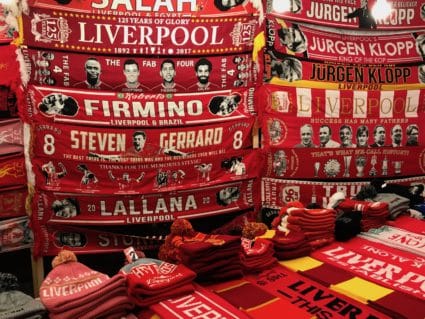


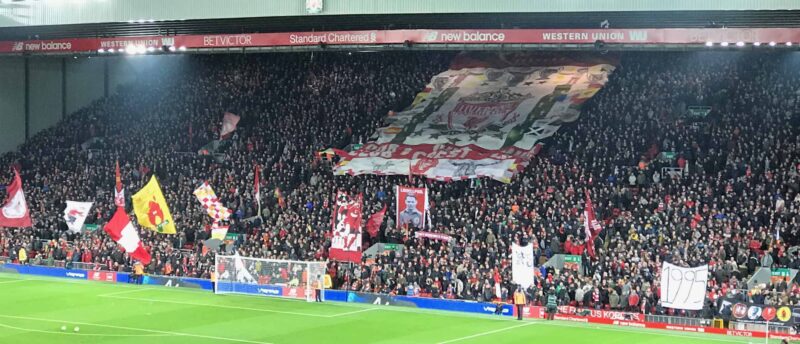

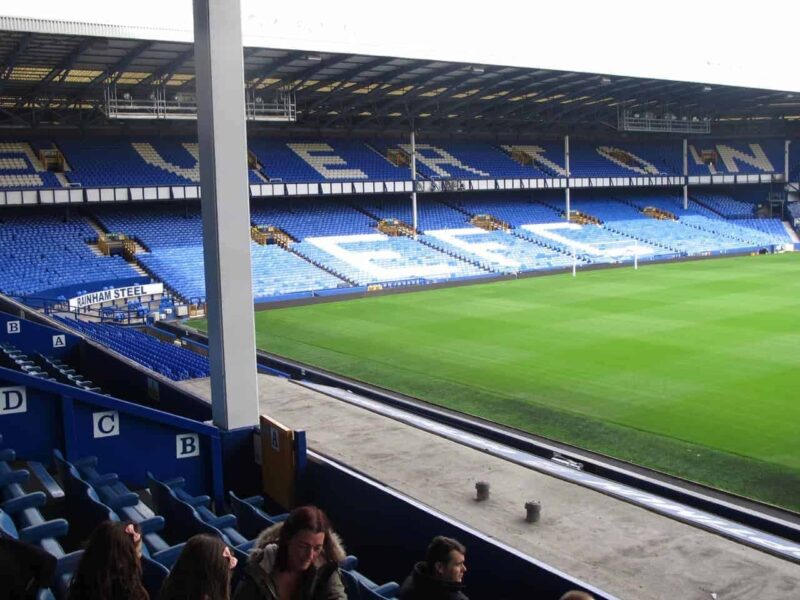

Post Comments